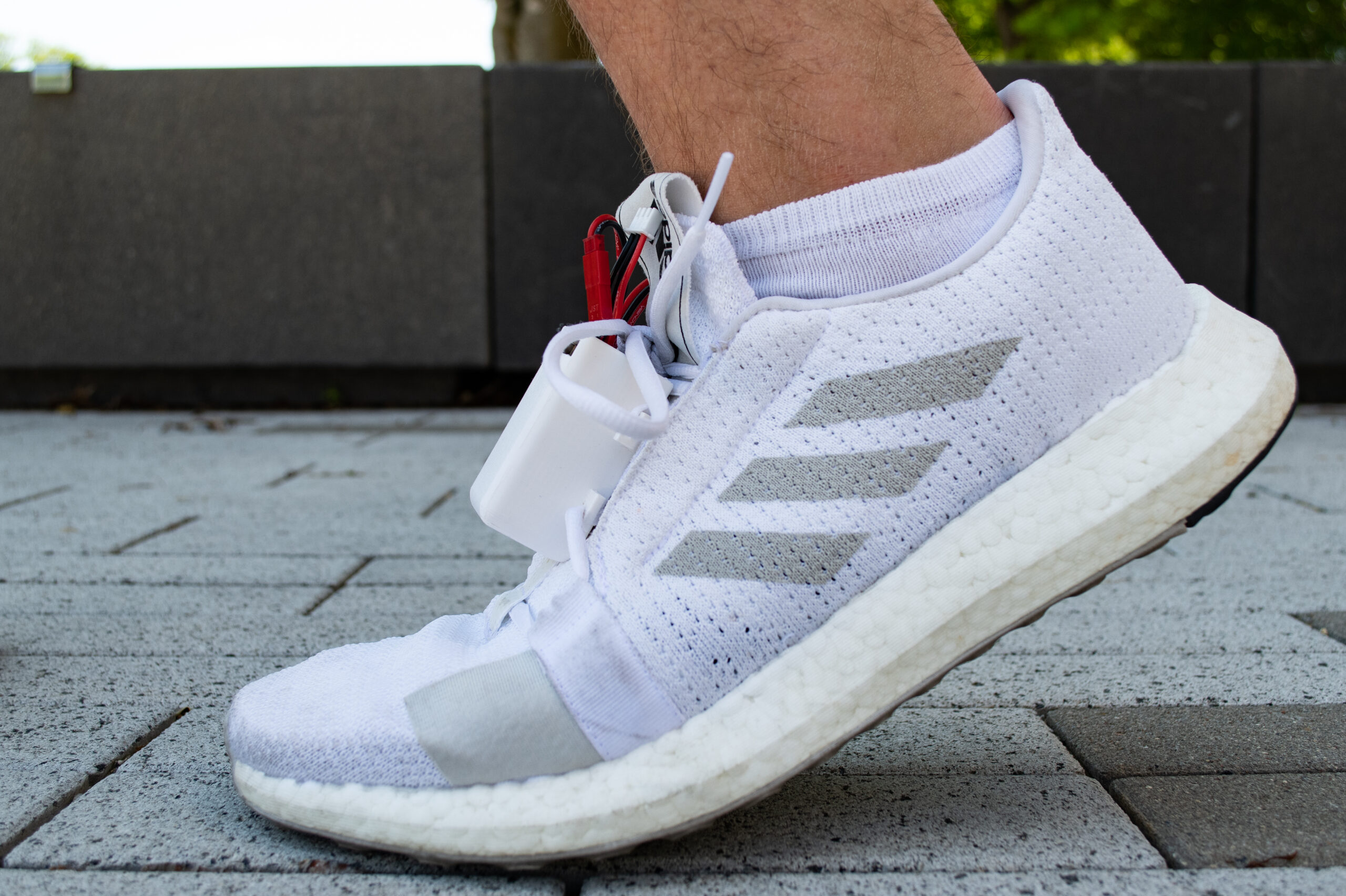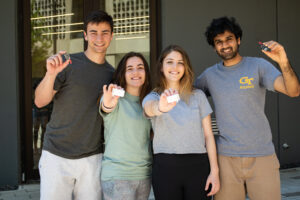How we walk is a key indicator of any injury, recovery pathway and overall health. Clinicians’ analysis for assessment of gait is still done in a highly subjective way with the naked eye. As such, physical therapists struggle to track patients’ recovery and therapeutic process without a technical, objective yet visual solution for gait assessment.
Enter StrideLink, a new technology venture borne from the minds of Georgia Tech students Marzeah Khorramabadi (CmpE), Cassandra McIltrot (BME), Neel Narvekar (CmpE) and Tony Wineman (EE).
From the team’s Spring 2021 Capstone Expo description, “Our mission became creating affordable and accessible gait analysis technology using components commonly found in other wearable activity trackers. StrideLink is a first of its kind wearable gait tracking device. StrideLink was tested against a $40,000 research grade system and was shown to be within nominal margins of error. We are looking forward to seeing what kind of impact this device can have on how people recover during physical therapy and the potential role it can play in a telehealth appointment.”
StrideLink persists by advancing its mission through Georgia Tech CREATE-XSM. “CREATE-X is helping build the future by offering entrepreneurship programs for all students, from incoming freshmen and undergraduate students of all years, to masters and Ph.D. students. Startups that have gone through the CREATE-X initiative have created dozens of new jobs, generated tens of millions of dollars in revenue, secured institutional financing, and run successful crowdfunding campaigns. These startups serve both large corporate customers and hundreds and thousands of consumers.”
The team recently completed the “Startup Launch” program within CREATE-X. Startup Launch is a program for Georgia Tech students and alumni who want to launch their projects from the idea stage (or beyond) into fully functioning and viable startups.
MD not required: BME, EE and CmpE have massive potential to improve outcomes in large patient populations
“I thought I wanted to be a doctor,” Cassie said. “But I’m always asking ‘Why,’ and ‘What else can be done?’ I realized I could have a bigger impact as an engineer than a physician. This realization and the way Georgia Tech emphasizes progress and service is the reason I’m here.”
“Same here,” Zea told us, referring to an early interest in becoming a physician. “After talking to a few medical students, it became clear to me I would likely be frustrated trying to change lives from the provider side of the equation. A lot of computer scientists make careers in the defense industry; also not for me. Computer engineers can create solutions that improve outcomes and reduce cost of care for very large patient populations and the clinicians that treat them. Wearables have almost endless potential in this regard. We have only scratched the surface of how much we can measure and its potential to improve lives.
A navigator and launch pad for medtech and life science innovation: right here at Georgia Tech
Bringing a new medical technology to market, be it diagnostic or therapeutic, is fraught with pitfalls that can doom even the most promising innovations. Medtech innovation needs to follow a specific pathway for successful commercialization.
GCMI provided weekly office hours, educational workshops and ad hoc consulting services for CREATE-X teams with innovative medical technologies. GCMI further assisted in brainstorming activities, risk assessments, bill of materials generation and clinical need assessments, gratis for multiple CREATE-X teams including StrideLink.
GCMI is the navigator and launch pad for medtech and life science innovation that saves lives and improves patient care. We use a phase-gated process that allows for a resource efficient, disciplined medical technology design and product development approach. Our medical device design services and development process encourages an early focus on clear problem definition and de-risking a wide variety of potential solutions. By later phases, the funnel of medical device design options narrows significantly, converging on a final product that has been thoroughly shown to meet the customer needs and is ready for distribution. Our customers include principal investigators, inventors, engineers and product managers, including academic faculty at Georgia Tech. We also serve large health systems and many of the largest medtech and life science companies at home and abroad.
Before you build, listen
“Don’t build first, listen,” Zea advises others with innovative ideas for new medical technologies. “This can be inherently difficult for engineers, designers and builders. But it’s immensely important. You’ll get it wrong if you don’t listen [closely to the customers’ or users’ needs first].”
With a firm grasp of the unmet clinical need, the StrideLink team is addressing gait asymmetry with a small sensor that collects relevant data and delivers it to physical therapists and associated clinicians in a visual format designed to aid in patient demonstration, communication and ultimately, recovery.
“The feedback Mike [Fisher], Evan [Goldberg] and Emily [Blum] provided in our first office hours meeting included guidance on the unique language and content requirements that are unique to the medical technology ecosystem to which we had not yet been introduced,” Cassie said.
The GCMI team further provided guidance on quality assurance, failure modes and effectiveness analysis (FMEA) and regulatory guidance to the StrideLink team.
“They picked apart our device manual, identified potential failures, corresponding severity and translated what those issues meant not just for our next iteration, but how to communicate how to use the technology beyond the manual,” Cassie said. “The education Mike provided on FDA resources including devices on the market that have achieved FDA approval, what the data means and product codes that are potential fits for our device was immensely valuable to our continuing commercialization efforts.”
Focus on quality, getting it right the first time as a competitive advantage
“Most startups don’t consider quality assurance or regulatory strategy and classification early enough in the process,” Zea said. “Yet they have an immense impact on the technology’s design and development pathway. We definitely shifted our mindset on the design team’s impact on successfully delivering our technology to the market, thanks to GCMI’s guidance. How should we be designing quality checks into our system? What documentation should we have locked up at the conclusion of each step along the way? What’s needed for our technology to scale when the time comes, especially with respect to manufacturing and component availability?
“We have certainly placed the utmost importance on doing things right the first time, something that will embed in our company’s culture, especially if an FDA Class II classification is the best fit for our future technology’s potential.”
“Establishing best practices early in your startup’s path should increase the likelihood of future success,” Cassie said. “The Silicon Valley mentality does not work for health technology innovation. There are many, many well known stories of startups that met their demise because they failed to understand regulatory requirements early enough, if ever. Enhancing the founding team’ focus on quality, and doing things the right way early will give us a big advantage when it comes to our commercial success potential.”
GCMI would like to thank Cassie and Zea for helping us tell their story. We wish them and the entirety of the StrideLink team continued success.

